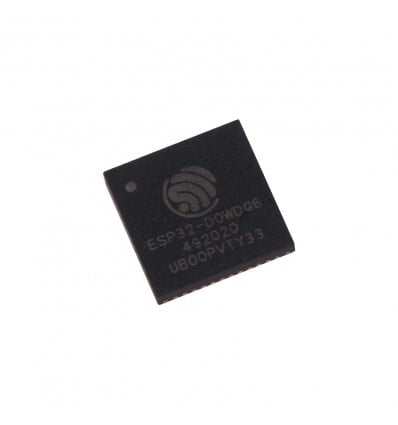International shipping Secure payment
No products
Prices are tax included
Product successfully added to your shopping cart
There are 0 items in your cart. There is 1 item in your cart.
Repair your favourite ESP32 boards or create your own custom MCUs with the Espressif ESP32DOWDQ6 RF Transceiver IC, packed full of awesome features.
5+ In Stock Items
Free shipping on orders over R1250 - courier delivery and within South Africa
While it’s difficult to argue against the fact that Arduino Boards are incredibly fun to play around with, Makers who are looking for more advanced and powerful boards for more complex projects may have experimented with the more modernised Espressif Boards, and if you have, you may know just how powerful these boards are. In addition to offering a lot of what Arduino Boards do, Espressif boards step it up and provide even more functionality due to the extremely impressive modules that have been integrated into them. This is exactly why we’re pretty darn excited to get the Espressif ESP32DOWDQ6 WiFi & Bluetooth Transceiver SoC in stock, as this is essentially the “brain” of many ESP32 microcontrollers, offering an excellent level of functionality, with fast processing speeds, great ROM, SRAM and other features, as well as built-in WiFi and Bluetooth radio capabilities – making it a huge upgrade from previous generation MCUs in the hobbyist realm.
These ESP32-WROOM-32 Modules are stocked as a way for Makers like you to repair and maintain projects with accessible and affordable spares, but can also so you can experiment with integrating these Integrated SoC Chips directly into other projects. In a similar way to the Atmel Chips, these can be used to build an entirely customised ESP32 Based Board, or they can be used as a secondary MCUs for advanced and complex projects too, with a powerful Xtensa 32-bit LX6 CPU integrated directly into the SoC. This is complemented with a 448KB ROM, 520KB of RAM and even a 1Kbit eFuse for a little extra protection and functionality. Furthermore, with 4MB SPI Flash Memory and a built-in 40MHz crystal, this module is almost ready to go with a wide range of different projects from the moment you get it. Of course, as always, it’s a good idea to go through the datasheet to find out the ideal way to set this module up before diving straight in, but once you’ve gotten that sorted out, you can be prepared to some serious DIY with your Electronics.
Espressif ESP32DOWDQ6 RF Transceiver SoC - Technical Specifications: |
|
|
|
|
– Xtensa 32-bit LX6 |
|
– 2.4 GHz |
|
– 448 KB |
|
– 520 KB |
|
– 16 KB |
|
– 8 MHz |
|
– 150 KHz Adjustable |
|
– 34 |
|
– 12bit SAR, Up to 18 Channels |
|
– 2 x 8bit DAC |
|
– 10 |
|
– 4 x SPI – 2 x I2S – 2 x I2C – 3 x UART |
|
– SD / eMMC / SDIO |
|
– SDIO / SPI |
|
– Motor | LED, Up to 16 Channels |
|
– SHA | RSA | AES | RNG |
|
– MTDI | GPIO0 | GPIO2 | MTDO | GPIO5 |
|
– 2.3V to 3.6V DC |
|
– 6 x 6mm |
Espressif ESP32DOWDQ6 RF Transceiver SoC - Communication Specifications: |
|
|
– 802.11 b/g/n |
|
– 2.4 to 2.5 GHz |
|
– 11n, MCS7: 12 to 14 dBm – 11b Mode: 17.5 to 20 dBm |
|
– 11b, 1Mbps: -93 dBm – 11b, 11Mbps: -89 dBm – 11g, 6Mbps: -92 dBm – 11g, 54Mbps: -74 dBm – 11n, HT20, MCS0: -91 dBm – 11n, HT20, MCS7: -71 dBm – 11n, HT40, MCS0: -89 dBm – 11n, HT40, MCS7: -69 dBm |
|
– 11g, 6Mbps: 31 dB – 11g, 54Mbps: 14 dB – 11n, HT20, MCS0: 31 dB – 11n, HT20, MCS7: 13 dB |
|
– 0 dBm |
|
– 3 dBm |
|
– -12 to +9 dBm |
|
– -97 dBm |
|
– 0 dBm |
|
– +10 dBm |
|
– -36 dBm |
Additional Resources:
- If you want to dive deeper into what this module is all about, as well as some of the lesser known features that it offers, then be sure to check out the official Espressif ESP32-WROOM-32 Documentation Page, where you can find data sheets, reference manuals and more.
- Next up, if you’re looking to use these SoC ICs in your projects, it’s probably a good idea to bookmark the Official ESP32 Forum, where community members help each other out, offer handy resources and provide a pretty great place to share your passion.
No customer reviews for the moment.
Espressif Systems have their headquarters based in Shanghai Zhangjiang High-Tech Park, which is considered to be “China’s Silicon Valley”, where they produce low-power WiFi and Bluetooth SoC’s and IoT hardware and software.
Their vision is to enhance the world by leveraging modern technologies like IoT and wireless communications to manufacture products that are more versatile, adaptable and eco-friendly, with the aim of reducing the amount of waste and pollution that the world produces each year. So far, they have been able to reduce the consumption of electrical components by hundreds of thousands of resistors, capacitors, inductors, baluns, switches and power management chips, while reducing the amount of Printed Circuits Boards, or PCB’s, by more than 50,000 square meters.
Espressif is quickly becoming the leading manufacturer of IoT and wireless components, modules and devices that cut out the need for cabling and unnecessary electronics, which will not only result in a world that is cleaner and more environmentally sustainable, but also more adaptable and capable of moving towards the future of human technologies.






